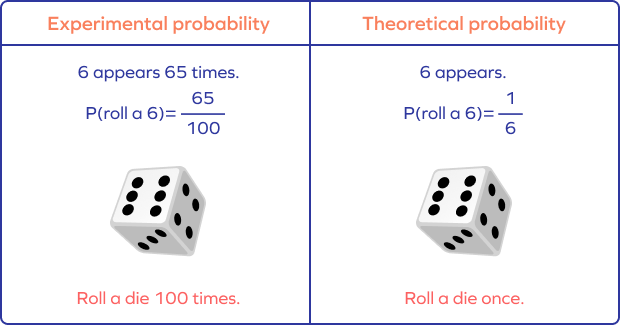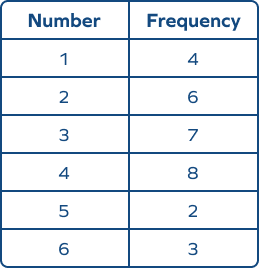- Math Article
- Experimental Probability

You and your 3 friends are playing a board game. It’s your turn to roll the die and to win the game you need a 5 on the dice. Now, is it possible that upon rolling the die you will get an exact 5? No, it is a matter of chance. We face multiple situations in real life where we have to take a chance or risk. Based on certain conditions, the chance of occurrence of a certain event can be easily predicted. In our day to day life, we are more familiar with the word ‘ chance and probability ’. In simple words, the chance of occurrence of a particular event is what we study in probability. In this article, we are going to discuss one of the types of probability called “Experimental Probability” in detail.

What is Probability?
Probability, a branch of Math that deals with the likelihood of the occurrences of the given event. The probability values for the given experiment is usually defined between the range of numbers. The values lie between the numbers 0 and 1. The probability value cannot be a negative value. The basic rules such as addition, multiplication and complement rules are associated with the probability.
Experimental Probability Vs Theoretical Probability
There are two approaches to study probability:
- Theoretical Probability
What is Experimental Probability?
Experimental probability, also known as Empirical probability, is based on actual experiments and adequate recordings of the happening of events. To determine the occurrence of any event, a series of actual experiments are conducted. Experiments which do not have a fixed result are known as random experiments. The outcome of such experiments is uncertain. Random experiments are repeated multiple times to determine their likelihood. An experiment is repeated a fixed number of times and each repetition is known as a trial. Mathematically, the formula for the experimental probability is defined by;
Probability of an Event P(E) = Number of times an event occurs / Total number of trials.
What is Theoretical Probability?
In probability, the theoretical probability is used to find the probability of an event. Theoretical probability does not require any experiments to conduct. Instead of that, we should know about the situation to find the probability of an event occurring. Mathematically, the theoretical probability is described as the number of favourable outcomes divided by the number of possible outcomes.
Probability of Event P(E) = No. of. Favourable outcomes/ No. of. Possible outcomes.
Experimental Probability Example
Example: You asked your 3 friends Shakshi, Shreya and Ravi to toss a fair coin 15 times each in a row and the outcome of this experiment is given as below:
Calculate the probability of occurrence of heads and tails.
Solution: The experimental probability for the occurrence of heads and tails in this experiment can be calculated as:
Experimental Probability of Occurrence of heads = Number of times head occurs/Number of times coin is tossed.
Experimental Probability of Occurrence of tails = Number of times tails occurs/Number of times coin is tossed.
We observe that if the number of tosses of the coin increases then the probability of occurrence of heads or tails also approaches to 0.5.

To know more about experimental probability and theoretical probability please download BYJU’S – The Learning App.
Leave a Comment Cancel reply
Your Mobile number and Email id will not be published. Required fields are marked *
Request OTP on Voice Call
Post My Comment
Register with BYJU'S & Download Free PDFs
Register with byju's & watch live videos.


Experimental Probability
Experimental probability: introduction, experimental probability: definition, experimental probability formula, solved examples, practice problems, frequently asked questions.
In mathematics, probability refers to the chance of occurrence of a specific event. Probability can be measured on a scale from 0 to 1. The probability is 0 for an impossible event. The probability is 1 if the occurrence of the event is certain.
There are two approaches to study probability: experimental and theoretical.
Suppose you and your friend toss a coin to decide who gets the first turn to ride a new bicycle. You choose “heads” and your friend chooses “tails.”

Can you guess who will win? No! You have $\frac{1}{2}$ a chance of winning and so does your friend. This is theoretical since you are predicting the outcome based on what is expected to happen and not on the basis of outcomes of an experiment.
So, what is the experimental probability? Experimental probability is calculated by repeating an experiment and observing the outcomes. Let’s understand this a little better.
Recommended Games

Experimental probability, or empirical probability, is the probability calculated by performing actual experiments and gathering or recording the necessary information. How would you define an experiment? The math definition of an experiment is “a process or procedure that can be repeated and that has a set of well-defined possible results or outcomes.”

Consider the same example. Suppose you flip the coin 50 times to see whether you get heads or tails, and you record the outcomes. Suppose you get heads 20 times and tails 30 times. Then the probability calculated using these outcomes is experimental probability. Here, t he experimental meaning is connected with such experiments used to determine the probability of an event.
Now that you know the meaning of experimental probability, let’s understand its formula.
Experimental Probability for an Event A can be calculated as follows:
P(E) $= \frac{Number of occurance of the event A}{Total number of trials}$
Let’s understand this with the help of the last example.

A coin is flipped a total of 50 times. Heads appeared 20 times. Now, what is the experimental probability of getting heads?
E xperimental probability of getting heads $= \frac{Number of occurrences}{Total number of trials}$
P (Heads) $= \frac{20}{50} = \frac{2}{5}$
P (Tails) $= \frac{30}{50} = \frac{3}{5}$
Experimental Probability vs. Theoretical Probability
Theoretical probability expresses what is expected. On the other hand, experimental probability explains how frequently an event occurred in an experiment.
If you roll a die, the theoretical probability of getting any particular number, say 3, is $\frac{1}{6}$.
However, if you roll the die 100 times and record how many times 3 appears on top, say 65 times, then the experimental probability of getting 3 is $\frac{65}{100}$.

Theoretical probability for Event A can be calculated as follows:
P(A) $= \frac{Number of outcomes favorable to Event A}{Number of possible outcomes}$
In the example of flipping a coin, the theoretical probability of the occurrence of heads (or tails) on tossing a coin is
P(H) $= \frac{1}{2}$ and P(T) $= \frac{1}{2}$ (since possible outcomes are $2 -$ head or tail)
Experimental Probability: Examples
Let’s take a look at some of the examples of experimental probability .
Example 1: Ben tried to toss a ping-pong ball in a cup using 10 trials, out of which he succeeded 4 times.

P(win) $= \frac{Number of success}{Number of trials}$
$= \frac{4}{10}$
$= \frac{2}{5}$
Example 2: Two students are playing a game of die. They want to know how many times they land on 2 on the dice if the die is rolled 20 times in a row.

The experimental probability of rolling a 2
$= \frac{Number of times 2 appeared}{Number of trials}$
$= \frac{5}{20}$
$= \frac{1}{4}$
1. Probability of an event always lies between 0 and 1.
2. You can also express the probability as a decimal and a percentage.
Experimental probability is a probability that is determined by the results of a series of experiments. Learn more such interesting concepts at SplashLearn .
1. Leo tosses a coin 25 times and observes that the “head” appears 10 times. What is the experimental probability of getting a head?
P(Head) $= \frac{Number of times heads appeared}{Total number of trials}$
$= \frac{10}{25}$
$= \frac{2}{5}$
$= 0.4$
2. The number of cakes a baker makes per day in a week is given as 7, 8, 6, 10, 2, 8, 3. What is the probability that the baker makes less than 6 cakes the next day?
Solution:
Number of cakes baked each day in a week $= 7, 8, 6, 10, 2, 8, 3$
Out of 7 days, there were 2 days (highlighted in bold) on which the baker made less than 6 cookies.
P$(< 6 $cookies$) = \frac{2}{7}$
3. The chart below shows the number of times a number was shown on the face of a tossed die. What was the probability of getting a 3 in this experiment?

Number of times 3 showed $= 7$
Number of tosses $= 30$
P(3) $= \frac{7}{30}$
4. John kicked a ball 20 times. He kicked 16 field goals and missed 4 times . What is the experimental probability that John will kick a field goal during the game?
Solution:
John succeeded in kicking 16 field goals. He attempted to kick a field goal 20 times.
So, the number of trials $= 20$
John’s experimental probability of kicking a field goal $= \frac{Successful outcomes} {Trials attempted} = \frac{16}{20}$
$= \frac{4}{5}$
$= 0.8$ or $80%$
5. James recorded the color of bikes crossing his street. Of the 500 bikes, 10 were custom colors, 100 were white, 50 were red, 120 were black, 100 were silver, 60 were blue, and 60 were gray. What is the probability that the car crossing his street is white?
Number of white bikes $= 100$
Total number of bikes $= 500$
P(white bike) $= \frac{100}{500} = \frac{1}{5}$
Attend this quiz & Test your knowledge.
In a class, a student is chosen randomly in five trials to participate in 5 different events. Out of chosen students, 3 were girls and 2 were boys. What is the experimental probability of choosing a boy in the next event?
A manufacturer makes 1000 tablets every month. after inspecting 100 tablets, the manufacturer found that 30 tablets were defective. what is the probability that you will buy a defective tablet, the 3 coins are tossed 1000 times simultaneously and we get three tails $= 160$, two tails $= 260$, one tail $= 320$, no tails $= 260$. what is the probability of occurrence of two tails, the table below shows the colors of shirts sold in a clothing store on a particular day and their respective frequencies. use the table to answer the questions that follow. what is the probability of selling a blue shirt.

Jason leaves for work at the same time each day. Over a period of 327 working days, on his way to work, he had to wait for a train at the railway crossing for 68 days. What is the experimental probability that Jason has to wait for a train on his way to work?
What is the importance of experimental probability?
Experimental probability is widely used in research and experiments in various fields, such as medicine, social sciences, investing, and weather forecasting.
Is experimental probability always accurate?
Predictions based on experimental probability are less reliable than those based on theoretical probability.
Can experimental probability change every time the experiment is performed?
Since the experimental probability is based on the actual results of an experiment, it can change when the results of an experiment change.
What is theoretical probability?
The theoretical probability is calculated by finding the ratio of the number of favorable outcomes to the total number of probable outcomes.
RELATED POSTS
- Length Conversion – Metric and Customary System, Examples
- How Many Weeks Are There in a Month? Definition with Examples
- Analog Clock – Definition, Clock Face, Clock Hands, Examples, Facts
- Slope of Parallel Line: Formula, Derivation, Example
- Milliliter – Definition with Examples

Math & ELA | PreK To Grade 5
Kids see fun., you see real learning outcomes..
Make study-time fun with 14,000+ games & activities, 450+ lesson plans, and more—free forever.
Parents, Try for Free Teachers, Use for Free

IMAGES
VIDEO